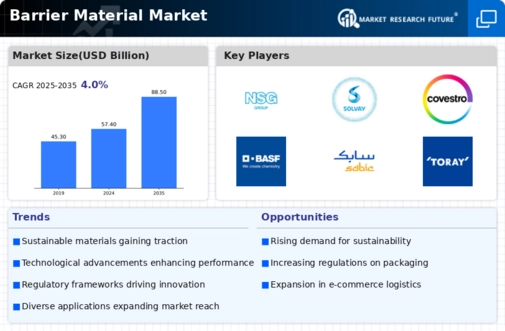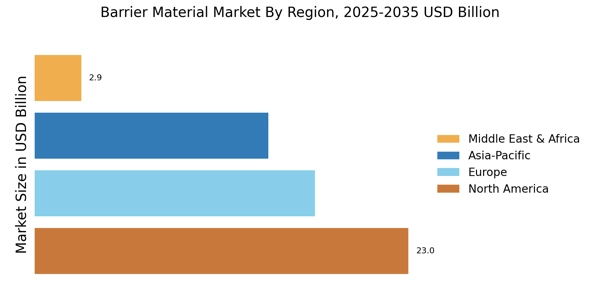Increased Regulatory Standards
Increased regulatory standards are a driving force in the Barrier Material Market, compelling manufacturers to adopt higher quality materials. Governments and regulatory bodies are implementing stringent guidelines to ensure product safety and environmental sustainability. This trend is particularly evident in the food and pharmaceutical sectors, where compliance with safety regulations is paramount. The market is witnessing a shift towards materials that not only meet these standards but also offer enhanced performance. As a result, companies are investing in research to develop barrier materials that align with regulatory requirements while maintaining cost-effectiveness. The emphasis on compliance is likely to shape product development strategies, making it a critical consideration for stakeholders in the Barrier Material Market.
Innovations in Material Science
Innovations in material science are reshaping the Barrier Material Market, leading to the development of advanced barrier solutions. Research and development efforts are yielding new materials that offer superior performance characteristics, such as enhanced barrier properties and reduced environmental impact. For instance, bio-based polymers and nanocomposites are gaining traction due to their potential to replace traditional materials. The market for these innovative solutions is anticipated to grow significantly, with projections indicating a potential increase of 20% in the next five years. This evolution not only addresses the demand for sustainable options but also enhances the functionality of barrier materials across various applications. As companies strive to differentiate their products, the integration of cutting-edge materials becomes a strategic imperative in the Barrier Material Market.
Rising Demand for Food Packaging
The increasing demand for food packaging is a pivotal driver in the Barrier Material Market. As consumer preferences shift towards convenience and longer shelf life, manufacturers are compelled to adopt advanced barrier materials that enhance product preservation. The food packaging segment is projected to account for a substantial share of the market, with estimates suggesting it could reach a valuation of over 30 billion dollars by 2026. This surge is attributed to the growing trend of ready-to-eat meals and the need for sustainable packaging solutions. Consequently, companies are investing in innovative barrier materials that not only meet regulatory standards but also cater to the eco-conscious consumer. The emphasis on reducing food waste further propels the demand for effective barrier materials, making this sector a critical focus for stakeholders in the Barrier Material Market.
Consumer Awareness and Sustainability
Consumer awareness regarding sustainability is increasingly influencing the Barrier Material Market. As individuals become more informed about environmental issues, there is a growing demand for eco-friendly packaging solutions. This shift is prompting manufacturers to explore biodegradable and recyclable barrier materials that minimize environmental impact. Market Research Future indicates that the sustainable packaging segment is expected to grow at a rate of 7% annually, reflecting the changing preferences of consumers. Companies that prioritize sustainability in their product offerings are likely to gain a competitive edge, as consumers are more inclined to support brands that align with their values. This trend underscores the importance of integrating sustainability into the core strategies of businesses operating within the Barrier Material Market.
Growth in Electronics and Consumer Goods
The expansion of the electronics and consumer goods sectors significantly influences the Barrier Material Market. As technology advances, the need for protective packaging that safeguards sensitive electronic components from moisture and contaminants becomes increasingly vital. The electronics segment is expected to witness a compound annual growth rate of approximately 5% through 2025, driven by the proliferation of smart devices and wearables. Barrier materials play a crucial role in ensuring product integrity, thereby enhancing consumer trust and brand loyalty. Furthermore, the rise of e-commerce necessitates robust packaging solutions that can withstand the rigors of transportation and storage. This trend underscores the importance of barrier materials in maintaining product quality, positioning them as indispensable components in the Barrier Material Market.


















Leave a Comment